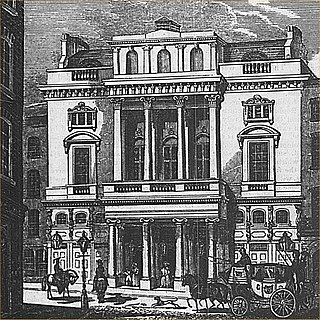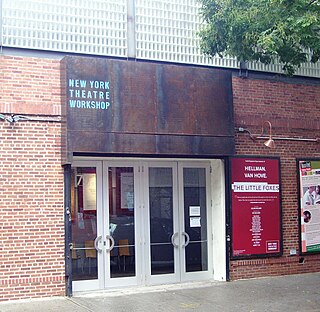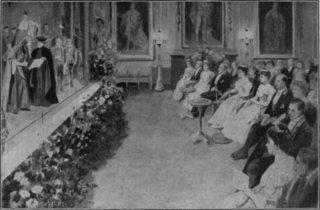
David Garrick was an English actor, playwright, theatre manager and producer who influenced nearly all aspects of European theatrical practice throughout the 18th century, and was a pupil and friend of Samuel Johnson. He appeared in several amateur theatricals, and with his appearance in the title role of Shakespeare's Richard III, audiences and managers began to take notice.

Stage management is a broad field that is generally defined as the practice of organization and coordination of an event or theatrical production. Stage management may encompass a variety of activities including overseeing of the rehearsal process and coordinating communications among various production teams and personnel. Stage management requires a general understanding of all aspects of production and provides complete organization to ensure the process runs smoothly and efficiently.

Stagecraft is a technical aspect of theatrical, film, and video production. It includes constructing and rigging scenery; hanging and focusing of lighting; design and procurement of costumes; make-up; stage management; audio engineering; and procurement of props. Stagecraft is distinct from the wider umbrella term of scenography. Considered a technical rather than an artistic field, it is primarily the practical implementation of a scenic designer's artistic vision.

The St James's Theatre was in King Street, St James's, London. It opened in 1835 and was demolished in 1957. The theatre was conceived by and built for a popular singer, John Braham; it lost money and after three seasons he retired. A succession of managements over the next forty years also failed to make it a commercial success, and the St James's acquired a reputation as an unlucky theatre. It was not until 1879–1888, under the management of the actors John Hare and Madge and W. H. Kendal that the theatre began to prosper.

The Oregon Shakespeare Festival (OSF) is a regional repertory theatre in Ashland, Oregon, United States, founded in 1935 by Angus L. Bowmer. The Festival now offers matinee and evening performances of a wide range of classic and contemporary plays not limited to Shakespeare. During the Festival, between five and eleven plays are offered in daily rotation six days a week in its three theatres. It welcomed its millionth visitor in 1971, its 10-millionth in 2001, and its 20-millionth visitor in 2015.

Broadway theatre, or Broadway, is a theatre genre that consists of the theatrical performances presented in 41 professional theaters, each with 500 or more seats, in the Theater District and Lincoln Center along Broadway, in Midtown Manhattan, New York City. Broadway and London's West End together represent the highest commercial level of live theater in the English-speaking world.

New York Theatre Workshop (NYTW) is an Off-Broadway theater noted for its productions of new works. Located at 79 East 4th Street between Second Avenue and Bowery in the East Village neighborhood of Manhattan, New York City, it houses a 198-seat theater for its mainstage productions, and a 75-seat black box theatre for staged readings and developing work in the building next door, at 83 East 4th Street.

The Criterion Theatre is a West End theatre at Piccadilly Circus in the City of Westminster, and is a Grade II* listed building. It has a seating capacity of 588.
A theatrical producer is a person who oversees all aspects of mounting a theatre production. The producer is responsible for the overall financial and managerial functions of a production or venue, raises or provides financial backing, and hires personnel for creative positions.

A Royal Command Performance is any performance by actors or musicians that occurs at the direction or request of a reigning monarch of the United Kingdom.

The Gaiety Theatre was a West End theatre in London, located on Aldwych at the eastern end of the Strand. The theatre was first established as the Strand Musick Hall in 1864 on the former site of the Lyceum Theatre. In 1868, it became known as the Gaiety Theatre and was, at first, known for music hall and then for musical burlesque, pantomime and operetta performances. From 1868 to the 1890s, it had a major influence on the development of modern musical comedy.

The Ambassador Theatre Group (ATG) is a major international theatre organisation headquartered in the United Kingdom, with offices in Woking, London, New York, Sydney, Mannheim and Cologne. ATG's key operations comprise three inter-related activities: theatre ownership and management, ticketing and marketing operations, and show productions.

The Globe was a Victorian theatre built in 1868 and demolished in 1902. It was the third of five London theatres to bear the name, following Shakespeare’s Bankside house, which closed in 1642, and the former Rotunda Theatre in Blackfriars Road, which for a few years from 1833 was renamed the Globe. The new theatre was also known at various times as the Royal Globe Theatre or Globe Theatre Royal. Its repertoire consisted mainly of comedies and musical shows.
Grant A. Rice is an American theatrical producer, manager, and consultant.

Booth's Theatre was a theatre in New York built by actor Edwin Booth. Located on the southeast corner of 23rd Street and Sixth Avenue, Booth's Theatre opened on February 3, 1869.
The following outline is provided as an overview of and topical guide to stagecraft:

An actor-manager is a leading actor who sets up their own permanent theatrical company and manages the business, sometimes taking over a theatre to perform select plays in which they usually star. It is a method of theatrical production used consistently since the 16th century, particularly common in 19th-century Britain and the United States.
The Theatre Royal in Dumfries, Scotland is the oldest working theatre in Scotland. The Theatre is owned by the Guild of Players who bought it in 1959, thereby saving it from demolition. The Guild's aim is to promote the tradition of live theatre in Dumfries. It is the venue for the Guild of Players' own productions and for performances from visiting companies. In addition it is used extensively as a venue for the Dumfries and Galloway Arts Festival, the Dumfries Music Festival and the Dumfries Musical Theatre Company.

Central Theatre was a Broadway theatre in New York City built in 1918. It was located at 1567 Broadway, at the southwest corner with 47th Street, and seated approximately 1,100 patrons. The architect was Herbert J. Krapp. The theatre was built by the Shubert family on a site previously occupied by the Mathushek & Son piano factory.
The Theatre Royal, Hanley was a theatre in Stoke-on-Trent, England with a long history.














